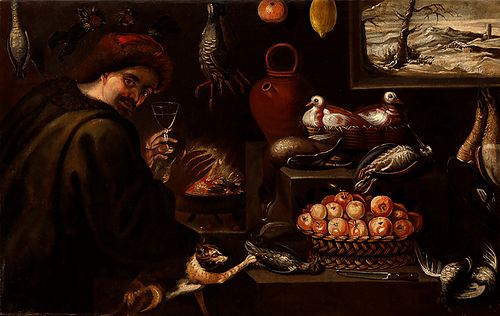Attributed to FRANCISCO BARRERA (Madrid, 1595 - 1658). "Still life of kitchen with figure and animals". Oil on canvas. Measurements: 86,5 x 136 cm.
Lot 106
About Seller
Setdart Auction House
Carrer Aragó 346
Barcelona
Spain
Setdart Subastas was born in 2004 and is currently the first online art auction in Spain with solidity, prestige and reliability guaranteed by our more than 60,000 users. Setdart has a young, dynamic and enterprising team ready to successfully manage the purchase and sale of art works through custom...Read more
Estimate:
EUR€25,000 - EUR€30,000
$26,881.72 - $32,258.06
Absentee vs Live bid
Two ways to bid:
- Leave a max absentee bid and the platform will bid on your behalf up to your maximum bid during the live auction.
- Bid live during the auction and your bids will be submitted real-time to the auctioneer.
Bid Increments
| Price | Bid Increment |
|---|---|
| EUR€0 | EUR€10 |
| EUR€200 | EUR€25 |
| EUR€500 | EUR€50 |
| EUR€1,000 | EUR€100 |
| EUR€3,000 | EUR€200 |
| EUR€5,000 | EUR€500 |
| EUR€10,000 | EUR€1,000 |
| EUR€20,000 | EUR€2,000 |
| EUR€50,000 | EUR€5,000 |
About Auction
By Setdart Auction House
Oct 20, 2021
Set Reminder
2021-10-20 07:30:00
2021-10-20 07:30:00
America/New_York
Bidsquare
Bidsquare : OLD MASTERS
https://www.bidsquare.com/auctions/setdart-auction-house/old-masters-7700
Setdart Auction House sofia@setdart.com
Setdart Auction House sofia@setdart.com
- Lot Description
Attributed to FRANCISCO BARRERA (Madrid, 1595 - 1658). "Still life of kitchen with figure and animals". Oil on canvas. Measurements: 86,5 x 136 cm. In this work the painting of figures is combined with the still life with animals, as it was frequent in the full baroque not only in Spain, but also in other schools like the Flemish or the Italian. We see a kitchen interior, where the stone plinths that recall Sánchez Cotán allow the different objects, fruits and animals to be placed in an orderly, staggered manner, allowing them to be perfectly viewed. Other details, such as the birds hanging on the wall or the basket on the lower step, also reveal Sánchez Cotán's knowledge of the artist. However, the painter introduces a figure who adds an enormous narrative and scenographic sense to the scene and also opens up the space to a snowy landscape, which reinforces the winter sense of the image, as does the brazier in front of which the figure warms his hands. From its style, formal features and even its subject matter we can attribute this work to Francisco Barrera, a still-life painter from the Madrid school of the first half of the 17th century. Documented as a master from 1923 onwards, he was particularly active during the 1930s and 1940s. Although he also produced landscapes, decorative and genre paintings, he excelled above all in still life painting. His painting enjoyed great success; his workshop had many disciples and he was a friend of other still-life painters such as Antonio Ponce and Juan de Arellano. He did, however, have some problems with the authorities. In 1934 his shops were investigated and several portraits of the king were taken away, as they were considered unseemly (there were very strict rules about the pictorial representation of Philip IV). Ten years later he was denounced to the Inquisition for producing religious works that did not conform to iconography. His still lifes reveal, above all, the influence of Juan de Van der Hamen, the leading figure in the Madrid school of the first half of the 17th century. However, being somewhat later, Barrera is less severe and geometric: he places the objects more intuitively, more randomly, is less meticulous in his description and does not take so much pleasure in the textures. Nor does he present the courtly tone of Van der Hamen's still lifes, but tends more towards the everyday. Thus Barrera depicts food in kitchen-like contexts although, from 1626 onwards, the supports were no longer tables but stone plinths such as the one we see here, influenced by Sánchez Cotán. Particularly famous were his seasonal still lifes such as this one, with seasonal foodstuffs, which became fashionable at court. Barrera represents a more advanced moment in the Baroque than Van der Hamen and Cotán: he sought asymmetry in his compositions, naturalism in the arrangement of the elements, and even opened up occasionally to landscape. Drawing predominates in his style, and he likes to place elements foreshortened, emerging from the surface on which they rest and accentuating the sensation of depth, as here the bird in the lower right corner. Francisco Barrera is represented in the Museum of Fine Arts in Seville, the National Museum of Slovakia, as well as in other important collections around the world, both public and private.
- Shipping Info
-
In-house shipping available. Please inquire at admin@setdart.com.
-
- Buyer's Premium



 EUR
EUR CAD
CAD AUD
AUD GBP
GBP MXN
MXN HKD
HKD CNY
CNY MYR
MYR SEK
SEK SGD
SGD CHF
CHF THB
THB






